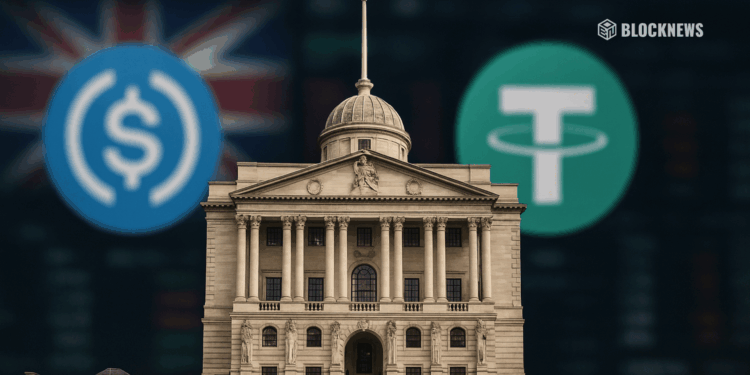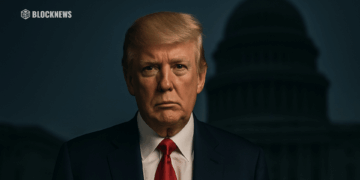- The Bank of England now proposes allowing systemic stablecoin issuers to invest up to 60% of reserves in government debt, with 40% held at the central bank.
- Temporary caps of £20,000 for individuals and £10 million for businesses remain in place, setting the UK apart from U.S. and EU approaches.
- Industry leaders welcome more flexibility but say clearer guidance is needed on when holding caps will be lifted and how far issuers can go into high-quality liquid assets.
The Bank of England (BoE) has signaled a noticeable shift in its approach to stablecoins, proposing on Monday that issuers of widely used tokens be allowed to invest up to 60% of their backing assets in government debt. That’s a big change from earlier plans and a clear nod to industry feedback.
Stablecoins are digital tokens designed to hold a steady value, typically pegged to a fiat currency like the pound or the dollar, and backed by traditional assets such as government bonds or cash. The sector has been booming, especially after the U.S. moved ahead with federal rules earlier this year, and the UK is now racing to define its own framework.

Back in 2023, the BoE floated a much harsher idea: forcing major stablecoin issuers to hold all reserves in non–interest-bearing accounts at the central bank. Industry voices slammed that plan, arguing it would kill stablecoin profitability and effectively block meaningful UK adoption. In the new proposal, the BoE has pulled back, suggesting that 40% of reserves must be held with the central bank, while the remaining 60% can be deployed into yield-bearing government debt.
Deputy governor for financial stability Sarah Breeden described the updated package as a key milestone, saying the bank has “listened carefully to feedback” and adjusted how it expects issuers to interact with the BoE as part of a wider UK stablecoin regime set for next year.
Temporary Flexibility for Existing Issuers
The BoE plans to oversee only those stablecoins it deems capable of becoming widely used for payments, rather than every token in the market. For firms already operating under the Financial Conduct Authority (FCA), the central bank is proposing a temporary regime that offers even more flexibility at the start. Under this setup, certain issuers could initially invest up to 95% of backing assets in permitted instruments, giving them time to transition into the stricter long-term structure.
At the same time, the BoE is exploring whether to offer central bank liquidity facilities to systemic stablecoin issuers during periods of market stress. In other words, in a crisis where issuers can’t sell their reserve assets fast enough in private markets, the BoE may step in as a backstop, similar to how it supports traditional banks. That’s a strong signal that the central bank is willing to treat large stablecoin providers as part of the broader financial plumbing—though with strings attached.
Stablecoins used primarily as trading instruments or held as assets for non-systemic purposes, such as buying and selling other crypto tokens, would sit outside the BoE’s direct remit. Those would instead be overseen by the FCA, reinforcing a split between payment-focused and trading-focused stablecoins.
Holding Caps: The Biggest Friction Point
Where the BoE has not softened is on holding limits, and this is where its stance stands out compared to the EU and U.S.
The proposal maintains caps on how much stablecoin individuals and businesses can hold:
- Up to £20,000 (around $26,842) for individuals
- Up to £10 million for businesses
Larger firms, such as supermarkets or trading platforms, could apply for exemptions, but for everyone else, these limits could significantly constrain the use of stablecoins for day-to-day treasury or payments activity. The BoE insists these caps are temporary, meant to ease financial stability concerns while the regime beds in, and says they will be lifted once those risks are judged to have subsided. But for now, they’re a major brake on widespread adoption.
Industry figures welcomed the greater clarity overall but said the BoE could have gone further. Tom Duff Gordon, vice president of international policy at Coinbase, argued that allowing up to 80% of backing assets in high-quality liquid instruments like government bonds would have been more appropriate. He also called for more detail on when and on what basis the caps might be removed, stressing that long-term planning is hard without that clarity.

A Step Forward, But Not a Free Pass
The new consultation, which runs until February 10, marks one of the clearest outlines yet of how the UK plans to treat systemic stablecoins. The BoE is clearly trying to strike a balance: give issuers enough room to operate profitably and integrate with traditional markets, while still guarding against runs, liquidity shocks, and the risk of a stablecoin becoming “too big to fail” overnight.
For the crypto industry, this is progress—but not a blank check. There’s more flexibility on how reserves can be invested, potential access to central bank liquidity, and a structured path from FCA oversight to BoE supervision. But the holding caps, reserve constraints, and case-by-case treatment of systemic players show that the UK intends to keep stablecoins firmly inside a prudential box as they scale.
Whether that framework ends up making the UK a leader in regulated stablecoins or slows domestic innovation compared to more permissive jurisdictions will depend on how quickly those “temporary” limits are relaxed, and how attractive the final rules look when they land next year.














